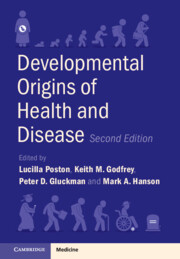Book contents
- Developmental Origins of Health and Disease
- Developmental Origins of Health and Disease
- Copyright page
- Contents
- Contributors
- Preface
- Section I Overview
- Section II Exposures Driving Long-Term DOHaD Effects
- Chapter 2 The Evolutionary Basis of DOHaD
- Chapter 3 Timing
- Chapter 4 Long-Term Effects of Food Insecurity and Undernutrition in Early Life
- Chapter 5 Short- and Long-Term Effects of Maternal Obesity and Dysglycaemia for Women and Their Children
- Chapter 6 Long-Term Effects of Prenatal Maternal Stress and Mental Health
- Chapter 7 Environmental Exposures in Early Life
- Chapter 8 Developmental Programming and the Microbiome
- Chapter 9 Exposures Driving Long-Term DOHaD Effects
- Section III Outcomes
- Section IV Mechanisms
- Section V Interventions
- Section VI Public Health and Policy Implications of Interventions
- Index
- References
Chapter 3 - Timing
Critical DOHaD Windows with Lifelong Effects
from Section II - Exposures Driving Long-Term DOHaD Effects
Published online by Cambridge University Press: 01 December 2022
- Developmental Origins of Health and Disease
- Developmental Origins of Health and Disease
- Copyright page
- Contents
- Contributors
- Preface
- Section I Overview
- Section II Exposures Driving Long-Term DOHaD Effects
- Chapter 2 The Evolutionary Basis of DOHaD
- Chapter 3 Timing
- Chapter 4 Long-Term Effects of Food Insecurity and Undernutrition in Early Life
- Chapter 5 Short- and Long-Term Effects of Maternal Obesity and Dysglycaemia for Women and Their Children
- Chapter 6 Long-Term Effects of Prenatal Maternal Stress and Mental Health
- Chapter 7 Environmental Exposures in Early Life
- Chapter 8 Developmental Programming and the Microbiome
- Chapter 9 Exposures Driving Long-Term DOHaD Effects
- Section III Outcomes
- Section IV Mechanisms
- Section V Interventions
- Section VI Public Health and Policy Implications of Interventions
- Index
- References
Summary
This chapter sets out experimental evidence for lasting effects of maternal and paternal exposures during critical windows of development around the time of conception, and points to the increasing evidence supporting adolescence and preconception as critical windows for the health of the next generation. This is set in the context of sections providing overviews of pregnancy and lactation, prematurity and infancy as more established critical windows during which environmental exposures can have lasting consequences for health and the risk of disease. Conceptually, these represent periods when timely interventions are considered to have the greatest potential for enhancing the development of functional capacity, thereby promoting resilience throughout the life-course.
- Type
- Chapter
- Information
- Developmental Origins of Health and Disease , pp. 16 - 26Publisher: Cambridge University PressPrint publication year: 2022



